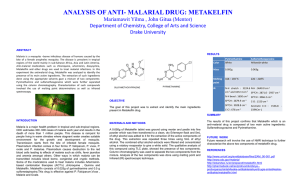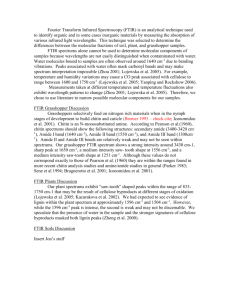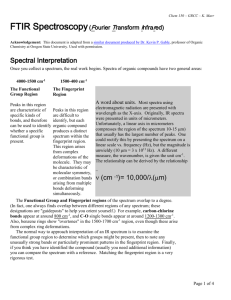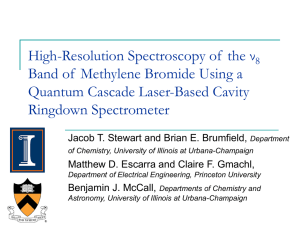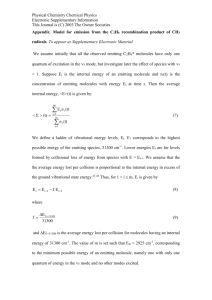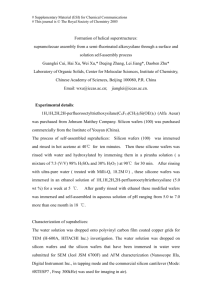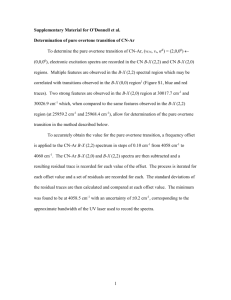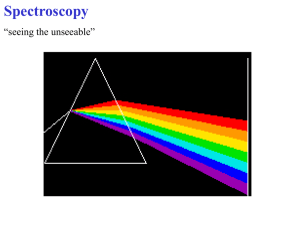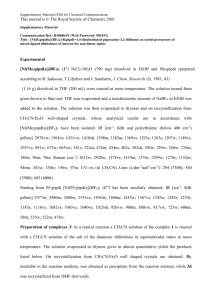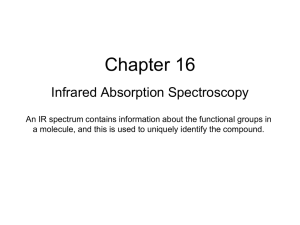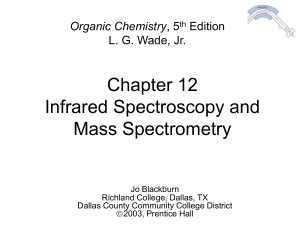CH3ONO Columbus 2010
advertisement
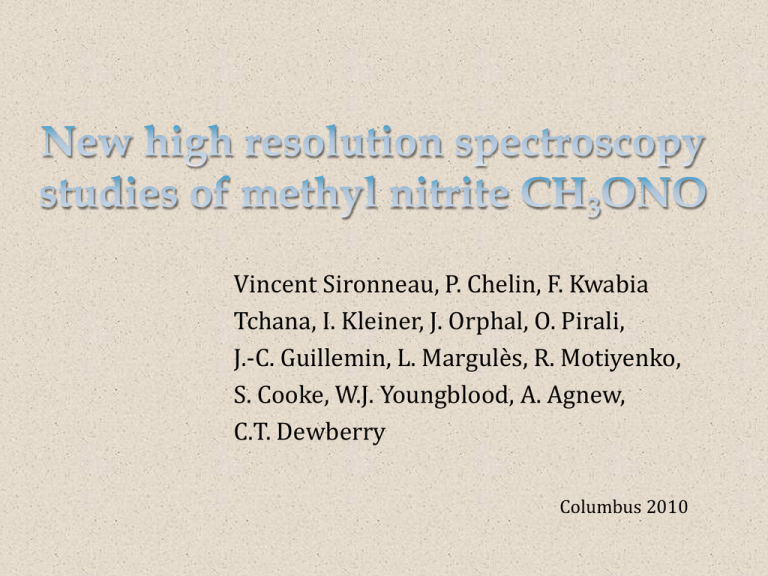
Vincent Sironneau, P. Chelin, F. Kwabia
Tchana, I. Kleiner, J. Orphal, O. Pirali,
J.-C. Guillemin, L. Margulès, R. Motiyenko,
S. Cooke, W.J. Youngblood, A. Agnew,
C.T. Dewberry
Columbus 2010
Produced by biomass burning
Involved in the photochemical oxidation of volatile
organic compounds
Rapid photolysis
Lifetime in the atmosphere? (2 minutes*)
Detection?
*W.D. Taylor, T.D. Allston, M.J. Moscato, G.B. Fazekas, R.Kozlowski, G.A. Takacs,
Int. J. Chem. Kinet. 12 (1980) 231–240.
cis-methyl nitrite
trans-methyl nitrite
Energy difference between the two isomers is approximately
275cm-1
cis-trans barrier height: 3786 cm-1
Internal rotation potential barrier:
-1
cis isomer : 739 cm
-1
trans isomer : 15 cm
Most studies concern cis-trans interconversion,
photofragmentation, UV absorption spectrum
J.B.P. da Silva, N.B. da Costa, M.N. Ramos, R. Fausto, J. Mol. Struct. 375 (1996) 153-180
B. J. van der Veken, R. Maas, G. A. Guirgis, H. D. Stidham, T. G. Sheehan, J. D. Durig, J. Phys. Chem. 94 (1990) 4029-4039
A. Untch, R. Schinke, R. Cotting, J.R. Huber, J. Chem. Phys. 99 (1993) 9553-9556
H.-M. Yin, J.-L. Sun, Y.-M. Li, K.-L. Han, G.-Z. He, S.-L. Cong, J. Chem. Phys. 118 (2003) 8248-8255
Two isomers
Internal rotation of the methyl group
Hyperfine structure (quadrupole of
nitrogen)
Low vibrational modes
Very weak torsional bands, not observed
with standard sources
Not commercial
The splitting depends of the height of the barrier
the higher the barrier is, the smaller the splittings are
Cis isomer: the
barrier V3 = 739 cm-1
Example for the
150,15-150,15 line
vt = 0 the A and E
lines separated
by 60 kHz
vt = 1 the splitting
E-A is 3.6 MHz
Trans isomer: the barrier V3 = 15 cm-1
free rotor, quantum number “m” for the torsional state
872 MHz for the 202-101 transition
Some low barrier molecules studied so far :
acetamide, V3 = 25 cm-1 (JMS 2004)
para-tolualdehyde V3 = 28 cm-1 Grabow et al WH07
meta-tolualdehyde
V3 = 35 cm-1, K. M. Hotopp
D. S. Wilcox, A. J. Shirar,
B. C. Dian, TC12, RH15
trans-methyl formate
V3 = 15 cm-1,Muckle et al,
Columbus 2009
Lines available in the literature for the cis:
60 lines for vt = 0 (J ≤ 20)
20 lines for vt = 1 (J ≤ 3)
20 for vt = 2 (J ≤ 3)
measurements/assignments errors: bad do-loops in
vt=1
A few lines (about 30) for the trans J < 5
Infrared spectra at low resolution of CH3ONO and
CD3ONO (1982)
Only one study at high resolution ν8 cis-CH3ONO
(2004)
P.N. Ghosh, A. Bauder, H.H. Günthard, Chem. Phys. 53 (1980) 39–50
P.H. Turner, M.J. Corkill, A.P. Cox, J. Phys. Chem. 83 (1979) 1473-1482
L. M. Goss, C. D. Mortensen and T. A. Blake, J. Mol. Spectrosc., 225, 182-188 (2004)
Presently the analysis deals only with the
cis-CH3ONO
First part:
New microwave measurements
Between 1 and 21 GHz, S. Cooke, W.J. Youngblood, A. Agnew,
C.T. Dewberry, University of North Texas (TC04)
Between 75 and 465 GHz, L. Margulès, R. Motiyenko, Phlam Lille
FIR in the French Synchrotron Soleil, V. Sironneau,
P. Chelin, F. Kwabia Tchana, I. Kleiner, J. Orphal, O. Pirali, J.-C. Guillemin
Second part:
MIR region at LISA Créteil, V. Sironneau, P. Chelin, F. Kwabia
Tchana, I. Kleiner, J.-C. Guillemin
Laurent Margulès and Roman Motiyenko
Cis isomer:
vt=2
n14 ~ 213 cm-1
n10 ~ 346 cm-1
vtors ~ 170 cm-1? (previous MW studies)
vtors ~ 214 cm-1 (this work)
Trans isomers:
vt=0, vt=1
n14 ~ 230 cm-1?
n10 ~ 379 cm-1
vtors ~ 26 cm-1?(E)
and 80 cm-1?(A)
Fit done with the Belgi-Cs
program
All parameters are in the
Rho Axis Method
Values in cm-1 except ρ
which is unitless
Number of lines
707 for vt=0
715 for vt=1
1 ≤ J ≤ 40
0 ≤ Ka ≤ 23
31 parameters
34kHz close to the
experimental accuracy
J. T. Hougen, I. Kleiner, and M. Godefroid, J. Mol.
Spectrosc. 163 (1994) 559-586
nlma
220
211
202
440
422
422
413
404
606
642
624
Operator
(1/2)(1-cos3γ)
Pγ²
PγPa
Pa2
Pb2
Pc2
(PaPb+PbPa)
Pγ4
(1/2)(1-cos6γ)
Pγ² Pa2
sin3γ (PbPc+PcPb)
(1-cos3γ)Pa2
(1-cos3γ)P2
(1-cos3γ) (PaPb+PbPa)
2 Pγ²(Pb2-Pc2)
Pγ Pa P2
Pγ Pa3
Pγ{Pa(Pb2-Pc2)}
- P4
- P2Pa2
- Pa4
- 2P2(Pb2-Pc2)
- {Pa2,(Pb2-Pc2)}
P2(PaPb+PbPa)
Pa2(PaPb+PbPa)
- {Pa2,(Pb2-Pc2)}
(1-cos6γ)P2
Pγ4 P2
Pγ4(Pb2-Pc2)
(1-cos3γ) P2(PaPb+PbPa)
(1-cos3γ) Pa2(PaPb+PbPa)
Parameterb
V3
F
ρ
ARAM
BRAM
CRAM
Dab
k4
V6
Gv
Dbc
k5
Fv
dab
c1
Lv
k1
c4
ΔJ
ΔJK
ΔK
δJ
δK
DabJ
DabK
φK
NV
MV
c3
dabJ
dabK
values
739(3)
6.183(18)
0.0861038(82)
0.591655(15)
0.332055(13)
0.1882082(31)
0.16835(1)
-0.405(13) ×10-3
76.26(41)
-0.5245(73) ×10-4
0.001352(85)
0.013938(31)
-0.00878(7)
0.010475(12)
-0.251(10) ×10-5
0.955(16) ×10-5
0.722(27) ×10-5
0.1877(82) ×10-5
0.2613(30) ×10-6
-0.30(35) ×10-7
0.210(69) ×10-5
0.855(15) ×10-7
0.378(13) ×10-6
0.103(12) ×10-6
-0.10357(8) ×10-5
0.39(2) ×10-11
0.002719(44)
-0.457(10) ×10-7
0.1856(69) ×10-7
-0.401(11) ×10-8
-0.429(28) ×10-7
Goals:
- Very weak torsional bands
150cm-1 (hot band progressions)
170cm-1 (previous MW studies)
214cm-1 (our study)
- High J and Ka values in the pure
rotational spectrum
O.Pirali, V. Sironneau, P. Chelin,
J. Orphal
Pure rotational spectrum of
CH3ONO recorded at the
French Synchrotron Soleil
Ghosh et al.[2]
P = 0.11 mbar, L = 150 m
Res = 0.0011cm-1
No resolved internal rotor
splittings in the FIR for the
cis-isomer
Waston type Hamiltonian in A
reduction, Ir representation
(Maki’s code)
Goss et al. [14]
This work
A
0.6762191(120)
0.6762192(16)
0.67621038(34)
B
0.2481020(1)
0.2481021(5)
0.24809892(21)
C
0.1878160(3)
0.1878163(5)
0.18781343(24)
ΔJ
2.25E-07(7)
2.2407E-07(76)
2.23938E-07(67)
ΔJK
-4.30E-07(43)
-5.11E-07(69)
-5.1759E-07(25)
ΔK
1.834E-06(70)
1.892E-06(17)
1.89466E-06(33)
δJ
7.0E-08(3)
6.654E-08(50)
6.7014E-08(11)
δK
1.8E-07(7)
2.42E-07(20)
2.4237E-07(34)
ΦJ
-1.45E-13(6)
ΦJK
8.37E-13(45)
ΦKJ
-1.09E-11(1)
ΦK
2.569E-11(9)
rms
110kHz
0.00044
0.00012
N.of lines
31 MW
32 MW+ 634 IR
2164 IR
J range
0-18
4-47
12-81
Ka range
0-7
0-17
0-48
Values in cm-1
resolution of 0.003cm-1
P=0.05 Torr, L=19.2m
resolution of 0.0019cm-1
P= 0.3 Torr, L=3.2m
Goss et al. Watson type Hamiltonian (634 lines) rms = 0.00044cm-1
But splittings for the low values of J and Ka and they are not included in
their fit
With BELGI-Cs (708 + 118 internal rotor splittings lines)
rms = 0.00048cm-1 (2 ≤ J ≤ 50, 0 ≤ Ka ≤ 22)
But V3= 623cm-1 (739cm-1 for the ground state) and F = 6.82cm-1
(6.18cm-1 for the ground state) effectives values
P.N. Ghosh, H.H. Gunthard, Spectrochim. Acta 37A (1981) 347–363
L. M. Goss, C. D. Mortensen and T. A. Blake, J. Mol. Spectrosc., 225 (2004) 182-188
Around 650 assigned
lines with a rms
0.00046cm-1
The internal rotor
splittings are not
included yet into the fit
Microwave analysis of
the vt=0 and vt=1 for
cis-CH3ONO (1422 lines
rms = 34kHz
J up 1 to 40, BELGI
code)
FIR pure rotational
spectrum of cis-methyl
nitrite (2164 lines
rms = 0.00012 cm-1
J = 12 up to 81, Maki’s
code)
Global analysis MW+FIR presents status :
3482 lines
1422 MW (707 in vt=0 and 715 in vt=1)
+ 2060 FIR ( 1342 in vt=0 and 718 in vt=1)
rms = 35kHz , 0.00018cm-1
Plan to search vt=2 for the cis-isomers
(expected perturbations with ν14 and ν10)
Need MW data for low J and Ka value to start
the study of trans-methyl nitrite…
For the ν8 band, our effective model
reproduce well the internal rotor splittings
(Spectral range for an atmospheric
detection?)
The analysis of the ν9 band is still in
progress: vibration-rotation-torsion
interactions need to be modeled!
In spite of several purifications (distillation)
a trace of methanol was still present
Solution 1: 11g of sodium nitrite
+ 6,4g of methanol in 50mL of
water
Solution 2: 8g of sulfuric acid +
14mL of water
Pour the solution 2 mL by mL in
the first one
In 800-900mbar nitrogen
atmosphere
Methanol is the principal
impurity
Methyl nitrite was condensed in
a trap at -80°C (pale yellow
liquid)

